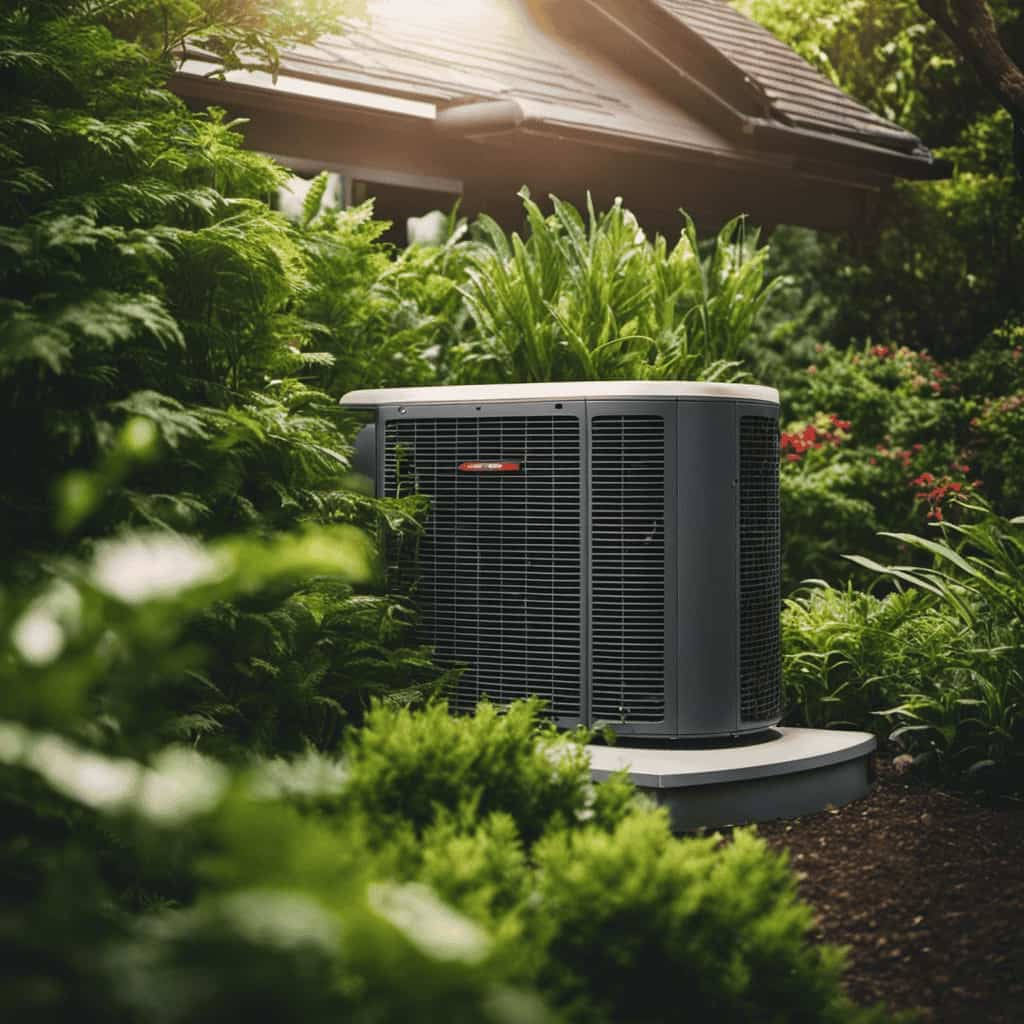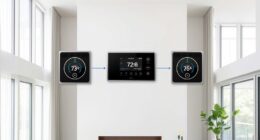In HVAC systems, conductive heat transfer occurs when heat moves through solid materials like metal ducts or radiant panels, offering quick and direct energy flow. Convective heat transfer involves the movement of fluids such as air or water, spreading heat throughout a space efficiently. Understanding how both mechanisms work helps you choose the right system for comfort and energy efficiency. Keep exploring to learn how these methods impact system design and indoor climate.
Key Takeaways
- Conductive heat transfer occurs through direct material contact, transferring heat via molecular vibration, ideal for radiant floors and metal ducts.
- Convective heat transfer involves fluid movement (air or water) to carry heat away from or toward surfaces, common in HVAC air circulation.
- Conductive transfer is slow in low thermal conductivity materials, while convection can rapidly distribute heat in fluids.
- HVAC systems utilize conduction in radiant heating surfaces and convection in fans and air handlers for effective temperature control.
- Both mechanisms often work together in buildings, with conduction transferring heat through walls and convection distributing it indoors.
What Is Conductive Heat Transfer?

Conductive heat transfer occurs when heat moves through a material without the material itself moving. The rate of this transfer depends on the material’s thermal conductivity—a measure of how easily heat passes through it. Materials with high thermal conductivity, like metals, transfer heat quickly, making them ideal for heat conduction applications. Conversely, materials with low thermal conductivity, such as wood or foam, act as effective insulators by slowing down heat flow. This property is essential in designing insulation for buildings, appliances, and other systems, as it helps control temperature and improve energy efficiency. Understanding the material’s insulation capabilities and thermal conductivity allows you to choose the right materials for specific heating or cooling needs, optimizing performance and reducing energy costs. Additionally, considering the thermal insulative properties of materials can further enhance energy conservation efforts.
How Does Convective Heat Transfer Work?

Convective heat transfer occurs when heat is transferred through the movement of fluids, such as liquids or gases. This process relies on the fluid’s ability to transport thermal energy, which depends on its thermal conductivity. When a fluid heats up, its molecules move faster, creating a temperature difference that drives heat flux from the hot area to the cooler surroundings. As the fluid moves, it carries thermal energy with it, increasing heat transfer efficiency. Understanding this process helps you optimize HVAC systems for better climate control by maximizing heat exchange through fluid motion. Additionally, the effectiveness of convective heat transfer can be influenced by the role of the fluid’s properties, which determine how well heat is transferred during circulation.
Material Properties and Their Impact on Heat Conduction

Material properties play a crucial role in determining how effectively heat is conducted through a substance. Your material’s conductivity directly influences how quickly heat moves, with higher conductivity meaning faster heat transfer. Conversely, materials with high thermal resistance slow down this process, acting as insulators. For example, metals like copper and aluminum have high material conductivity, making them excellent conductors for HVAC systems. On the other hand, materials like foam or fiberglass have high thermal resistance, reducing heat flow. Understanding these properties helps you select the right materials to optimize heat transfer efficiency. By choosing materials with appropriate conductivity and thermal resistance, you can improve your system’s performance, control energy loss, and enhance comfort within your space. Regular maintenance and understanding of material properties can further optimize heat transfer performance.
The Role of Fluid Movement in Convection

You can see how air circulation influences heat transfer by moving warm and cool air around a space. Ventilation systems impact how effectively heat is distributed, preventing hot spots and drafts. Understanding these dynamics helps you optimize airflow for better temperature control. Additionally, proper airflow management is crucial for energy efficiency in HVAC systems, reducing operational costs and environmental impact.
Air Circulation Dynamics
Air circulation dynamics are fundamental to understanding how convection transports heat. Your airflow patterns directly influence how heat moves through a space. When air moves efficiently, it redistributes thermal energy more evenly, enhancing comfort and energy efficiency. The speed and direction of airflow depend on factors like vents, fans, and obstacles, shaping the overall circulation. Thermal conductivity of materials nearby affects how quickly heat transfers between surfaces and the moving air, impacting convection effectiveness. Recognizing these dynamics helps you optimize HVAC systems by adjusting fan speeds, vent placements, and room layouts. Proper airflow ensures that warm or cool air reaches intended areas, reducing hot or cold spots. Additionally, understanding airflow patterns can help prevent issues like stagnant zones or uneven heating, leading to a more consistent indoor climate. Ultimately, understanding fluid movement’s role in convection allows you to create healthier, more comfortable indoor environments.
Impact of Ventilation
Ventilation plays a crucial role in shaping fluid movement, directly impacting how convection transfers heat within a space. When you increase ventilation, you’re encouraging air currents that enhance heat transfer through convection. This movement depends on the thermal conductivity of the air and other materials involved; higher thermal conductivity means quicker heat exchange. Proper ventilation also influences material insulation effectiveness. If ventilation disrupts insulation, heat can escape or enter more rapidly, reducing energy efficiency. Conversely, controlled ventilation can help maintain consistent temperatures by promoting fluid movement that evenly distributes heat. You should consider both ventilation strategies and material insulation when designing HVAC systems, as they work together to optimize convective heat transfer and improve overall climate control. Additionally, integrating AI in Business technologies can help optimize ventilation systems for energy efficiency and better climate management.
Comparing Efficiency: Conductive vs. Convective Heat Transfer

When comparing the efficiency of conductive and convective heat transfer, it’s important to understand how each process moves heat through different mediums. Conductive heat transfer relies on thermal conductivity, which measures how easily heat passes through a material. Materials with high thermal conductivity, like metals, dissipate heat quickly through conduction, making them efficient for direct heat transfer. Convective heat transfer, on the other hand, involves fluid movement—air or liquid—carrying heat away from surfaces. It’s often more effective in distributing heat over larger areas, especially when combined with natural or forced convection. Generally, conduction provides rapid heat dissipation at interfaces, while convection excels at spreading heat across spaces. The effectiveness of each method can also depend on surface properties, which influence how efficiently heat is transferred. Choosing the right method depends on your system’s design and the desired efficiency in heat transfer.
Applications of Conductive Heat Transfer in HVAC Systems

You can improve your HVAC system’s efficiency by focusing on wall insulation that uses conductive heat transfer to retain warmth. Radiant floor heating relies on conductive materials to evenly distribute heat across surfaces, providing comfort. Additionally, metal ducts facilitate heat transfer through their conductive properties, ensuring effective distribution of warm or cool air throughout your space. Incorporating proper space organization can also help optimize airflow and temperature regulation within your home.
Wall Insulation Efficiency
Wall insulation plays a essential role in enhancing the efficiency of HVAC systems by minimizing heat transfer through building envelopes. Proper insulation reduces thermal bridging, where heat bypasses insulation via conductive paths like studs or framing. Selecting effective insulation materials, such as foam, fiberglass, or mineral wool, helps create a barrier that resists heat flow. The better your insulation, the less your HVAC system needs to work to maintain comfortable temperatures. This results in energy savings and improved comfort. Keep in mind that gaps or poorly installed insulation can compromise efficiency by allowing heat to transfer through unintended pathways. Consequently, ensuring continuous, well-sealed insulation layers is critical for maximizing wall insulation efficiency and optimizing your HVAC system’s performance. Using HEPA filtration in conjunction with insulation can further improve indoor air quality and overall system effectiveness.
Radiant Floor Heating
Have you ever wondered how radiant floor heating efficiently warms a space? It relies on conductive heat transfer through radiant panels embedded in the floor. These panels have high thermal conductivity, allowing heat to spread evenly across the surface. When the system heats, the floor radiates warmth directly to occupants, reducing energy loss. This method creates a comfortable environment without air drafts. Here’s a visual overview:
| Component | Function | Material Focus |
|---|---|---|
| Radiant panels | Emit heat through conduction | High thermal conductivity |
| Floor surface | Transfers heat to room air | Conductive materials |
| Heat source | Provides energy for conduction | Efficient heating elements |
This setup showcases conductive heat transfer, making radiant floor heating a highly effective HVAC application. Additionally, understanding SWIFT/BIC codes can be important when managing international equipment and parts procurement for such systems.
Heat Transfer in Metal Ducts
Metal ducts in HVAC systems efficiently transfer heat through conduction, ensuring that heated or cooled air reaches its destination with minimal energy loss. Metal conductivity allows these ducts to quickly transfer thermal energy, making them a practical choice for maintaining temperature control. However, without proper duct insulation, heat can escape or enter through the duct walls, reducing efficiency. Insulating your metal ducts helps minimize conductive heat transfer to the surrounding environment, preserving energy and maintaining system performance. When designing or upgrading your HVAC system, consider the metal’s high conductivity and the importance of insulation to optimize heat transfer. Properly insulated metal ducts not only improve efficiency but also extend the lifespan of your system by reducing unnecessary thermal stress.
How Convection Affects Indoor Air Quality and Comfort

Since convection plays a key role in how indoor air circulates, it directly influences both air quality and comfort levels. Proper airflow helps remove pollutants, dust, and allergens, improving your indoor environment. It also ensures even temperature distribution, reducing cold or hot spots. Effective convection supports humidity control, preventing excess moisture that fosters mold and bacteria growth. Installing an air purifier with good airflow enhances air quality further, while balanced convection maintains comfort. To optimize these effects, consider the following:
| Effect | Benefit |
|---|---|
| Improved Circulation | Removes airborne contaminants |
| Humidity Balance | Maintains comfortable moisture |
| Temperature Uniformity | Prevents hot/cold zones |
| Enhanced Comfort | Creates a healthier environment |
Factors Influencing Heat Transfer Mechanisms in Buildings

Several factors determine how heat transfers within buildings, substantially impacting energy efficiency and occupant comfort. First, the quality of thermal insulation plays a crucial role; better insulation reduces conductive heat loss. Second, the building’s materials affect heat transfer; materials with high thermal conductivity promote conduction, while porous materials favor convection. Third, air leakage impacts convective heat transfer; sealing gaps helps conserve energy. Fourth, exterior climate conditions influence transfer mechanisms; colder climates demand enhanced insulation for energy conservation. Understanding these factors helps you optimize building design to minimize unwanted heat flow, improve energy efficiency, and maintain comfort. By controlling these elements, you can effectively manage conductive and convective heat transfer, ensuring your building remains energy-efficient and comfortable year-round.
Designing HVAC Systems for Optimal Heat Transfer Performance

Effective HVAC system design hinges on optimizing heat transfer to guarantee energy efficiency and comfort. To achieve this, you need to take into account materials with high thermal conductivity, which facilitate better heat dissipation. Proper insulation minimizes unwanted heat transfer, helping maintain desired indoor temperatures. You should also design airflow patterns that promote effective convection, enhancing heat exchange between indoor air and heat sources. Incorporate strategically placed vents and fans to improve heat dissipation, reducing load on heating and cooling units. Selecting equipment that balances conductive and convective transfer maximizes efficiency. By understanding and leveraging these principles, you ensure your system operates at its best, lowering energy costs and providing consistent comfort throughout the space.
Frequently Asked Questions
How Do Insulation Materials Influence Conductive Heat Transfer in Buildings?
You can improve your building’s insulation effectiveness by choosing materials with high thermal resistance. Insulation materials slow down conductive heat transfer, helping keep your indoor temperature stable. When you select insulation with higher thermal resistance, it reduces heat flow through walls, ceilings, and floors. This way, your building stays warmer in winter and cooler in summer, ultimately saving energy and increasing comfort. Proper insulation makes a significant difference in overall HVAC efficiency.
Can Natural Convection Significantly Impact HVAC Efficiency?
Natural convection can substantially influence HVAC efficiency by facilitating heat dissipation naturally. When warm air rises and cooler air sinks, it creates a cycle that enhances temperature regulation without extra energy. This process helps distribute heat evenly, reducing the workload on heating or cooling systems. By understanding and optimizing natural convection, you can improve system performance and save on energy costs, making your HVAC setup more effective and environmentally friendly.
What Role Does Humidity Play in Convective Heat Transfer Indoors?
Humidity effects play a key role in convective heat transfer indoors. When indoor moisture levels are high, the air becomes less dense, reducing its ability to transfer heat efficiently through convection. This can lead to uneven heating or cooling because the moist air resists temperature changes differently. By managing indoor moisture, you can optimize convective heat transfer, making your HVAC system more effective and improving overall comfort.
Are There Hybrid Systems That Utilize Both Conduction and Convection?
You may find hybrid systems that combine conduction and convection, offering a versatile approach to heating and cooling. These combined HVAC systems utilize conduction for direct heat transfer and convection for air circulation, improving efficiency. You benefit from better temperature control and energy savings. By integrating both methods, hybrid systems optimize indoor comfort and reduce energy consumption, making them an excellent choice for adaptable, efficient climate management.
How Is Heat Transfer Affected During Extreme Weather Conditions?
Imagine your home as a fortress facing a raging storm, where extreme weather tests your defenses. During such times, heat transfer intensifies through thermal bridging, allowing heat to escape or enter more easily, and the heat island effect amplifies outdoor temperature impacts. These factors make maintaining comfortable indoor conditions harder, requiring enhanced insulation and smarter HVAC strategies to protect your sanctuary from the relentless forces of nature.
Conclusion
Understanding the dance between conduction and convection helps you master HVAC design. Think of conduction as a steady drumbeat, while convection is the lively swirl of a dance floor. By tuning into these forces, you can craft systems that flow seamlessly, keeping your indoor environment cozy and efficient. Embrace the rhythm of heat transfer, and you’ll orchestrate comfort that feels just right—like a melody that soothes your every breath.









